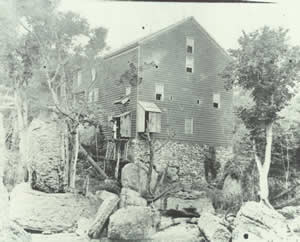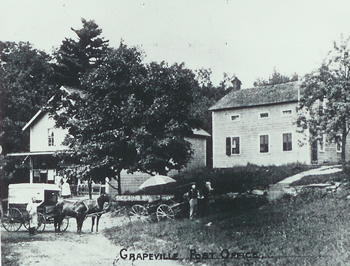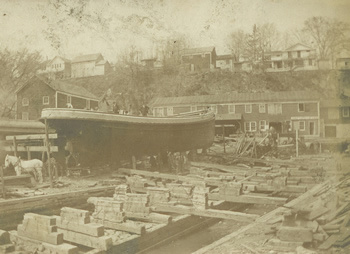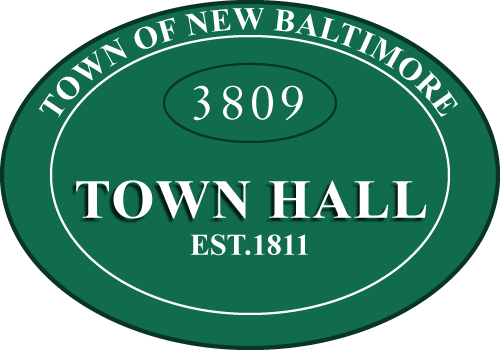Town Historian: Ted Hilscher
This email address is being protected from spambots. You need JavaScript enabled to view it.
New Baltimore History
Brief History of the Town of New Baltimore
History of Town Supervisors
Rocky Store School
Resources
New Baltimore History - A Reading List
Researching the History of Your House
Selected History Links
6-25-14 Sylvandale Part 2
6-25-14 Town History Displayed
Brief History of the Town of New Baltimore

Dean’s Mill about the turn of the 20th century - there were grist mills, saw mills, and even a paper mill in New Baltimore - prominent examples besides Dean’s were Van Bergen’s on the Coxsackie Creek, the Powell mill on the Potic Creek, and the Croswell paper mill on the Hannacroix.
New Baltimore was carved from the Town of Coxsackie on March 15, 1811 by an act of the New York State Legislature. Originally part of the homeland of the Mahican Indians, the Town’s boundaries were within the patents granted by the Dutch and English governments to early settlers such as Barent P. Coeymans and Mathias Houghtaling.

Badgley store and post office in Grapeville - turn of 20th century - Charles Badgley was Grapeville Postmaster - Building burned 1910.
Original settlement dates from at least 1713. Even before formal creation of the Town, the area had thriving mills and farms from the hamlet on the Hudson to what became the settlements of Medway, Grapeville, Stanton Hill, Staco, and their surroundings. Farming continued to grow in subsequent years and continues on a smaller scale today. By 1875, there were 248 farms with 33, 882 acres under cultivation. By the period between World Wars I and II, the Town was second in the County behind in Cairo in acreage devoted to fruit growing and had the largest individual orchards.

Baldwin shipyard about the turn of the 20 century - built about 150 vessels from the mid-1800s through the beginning of the 20th century - New Baltimore had numerous riverside businesses over the years, including Hudson River trades, ice houses, general stores, hotels, and at least 2 short-lived newspapers.
New Baltimore has been closely associated economically with the Hudson. The natural little bay on the Rivers west shore made a ready spot for handling cargo and passengers, with farmers and millers forming long lines to unload their goods. Shipbuilding and repair reached its peak in the mid-nineteenth century when the Baldwin family took charge and built over 150 barges, tugboats, ferries, and other craft. Because of business demands, the hamlet and other parts of Town had hotels and stores of various types, which lasted well into this century.
From the middle of the 1800s to the advent of powered refrigeration, ice harvesting became a prominent local business, with as many as nine ice houses in Town at one time.Besides tending their farms, mills, and maritime businesses, the settlers began to create the institutions that make up a town.
Churches
Religion formed an important part of the Town’s early life. Methodist ministers traveled upriver in the late 1700s to establish religion on the Coeymans Patent. New Baltimore was part of their circuit. Many settlers in the late 1780s were Quakers. They had migrated from Rhode Island and Long Island to Westchester County and up the Hudson in search of good farmland, centered at first in the Stanton Hill area. The Medway Congregational Christian Church was established in 1807, followed by the Grapeville Baptist Church, the New Baltimore Reformed Church, the Medway Methodist Church, First Baptist Church of New Baltimore, and most recently, the Grace Covenant Church.
Schools
In 1812, the New York State Legislature provided for establishing a system of common schools throughout the State. Quickly taking the initiative, the newly organized New Baltimore Commissioners of Common Schools met and divided the Town into 9 school districts. By 1866, the Town’s districts numbered 17. As the 1920s dawned, many rural school districts were facing shrinking enrollments and tax bases and pressure increased for the consolidations that the State had been promoting for some years. Thus, the Town’s schools started to disappear into surrounding districts, with the last going in 1963.
Fire Companies
In 1896, property belonging to a local tailor burned in the hamlet. As a result, several prominent businessmen organized the Cornell Hook and Ladder Company, named in honor of a primary benefactor of the Company. As the population grew toward the western part of Town, local citizens were motivated to establish another company. Previously relying on Greenville or Coxsackie for fire coverage, they established the Medway-Grapeville Fire Company, which was formally incorporated in 1947.
The Town has never been isolated from the rest of the world, with River traffic and ten New York Central trains stopping at New Baltimore Station daily in 1910. However, the opening of Route 9W may have been the pivotal point in Town history. A result of the coming of the automobile age and the first modern highway built to link Albany to the south, this road made it easier to commute. So today, New Baltimore with its rich history is primarily a residence for those who still farm and run local businesses, retirees, and people who work in places like Albany, Selkirk, and other parts of Greene County.
History of Town Supervisors
| Teunis A. VanSlyke | 1811 - 1813,1817,1824 |
| Conrad Houghtaling | 1814, 1821 - 1823 |
| Anthony VanBergen | 1815 - 1816, 1818 - 1820 |
| Gilbert Bedell | 1825 - 1831, 1834 - 1835 |
| Anthony C. Houghtaling | 1832 - 1833 |
| Thomas C. Houghtaling | 1836 - 1837, 1839 |
| Jonathan Miller | 1838, 1840 |
| Thomas Bedell | 1841 - 1842 |
| Lewis Crandell | 1843 - 1844 |
| Jesse Greene | 1845 - 1846 |
| Matthew Youmans | 1847 |
| Gerry Coonly | 1848 - 1849 |
| Edward E. Sherman | 1850 |
| Amos Houghtaling | 1851 - 1852 |
| Nathaniel O. Palmer | 1853 - 1854 |
| Henry A. Whitbeck | 1855 - 1857 |
| John G. Raymond | 1858 - 1859 |
| Peter Stover | 1860 - 1861 |
| Edgar Halstead | 1862 - 1863 |
| David S. Miller | 1864 - 1865 |
| Jedediah R. Baldwin | 1866 - 1867 |
| William W. Wheeler | 1868 - 1869 |
| Jeremiah Dean | 1870 - 1871 |
| Benjamin B. Hotaling | 1872 - 1873 |
| Warren Smith | 1874 - 1875 |
| Henry Harden | 1876 |
| Augustus Sherman | 1877 - 1878 |
| Joseph A. Losee | 1879 |
| John Colvin | 1880 - 1881 |
| Peter R. Cary | 1882 - 1883 |
| John W. Stover | 1884 - 1885 |
| Newton Sweet | 1886 |
| Henry VanBergen | 1887 - 1888 |
| Jasper K. Hotaling | 1889 - 1891 |
| William C. Harden | 1892 - 1893 |
| Charles W. Mackey | 1894 - 1899 |
| Cornelius V. Elmendorf | 1900 - 1903 |
| Bronk VanSlyke | 1904 - 1907 |
| Ezra H. Palmer | 1908 - 1909 |
| Henry J. Miller | 1910 - 1913 |
| Dale S. Baldwin | 1914 - 1918; 1936 - 1941 |
| Edwin C. VanderPoel | 1918 - 1919 |
| Orville G. Hotaling | 1920 - 1925 |
| Levitt C. Powell | 1926 - 1933 |
| Oscar E. Yeomans | 1934 - 1935 |
| Cecil C. Hallock | 1942 - 1961 |
| Clare A. Robbins | 1962 - 1967 |
| Clifton S. Baldwin | 1968 - 1969 |
| William Finke, Jr. | 1970 - 1971 |
| Nils Backlund | 1972 - 1981 |
| Robert C. Hallock | 1982 - 1984 |
| Sal Costanza | 1985 - 1986 |
| Donald McBride | 1987 |
| Gordon Kliese | 1988 |
| Eleanor Shafer | 1988 - 1990 |
| Robert C. Hallock (Acting) | 1990 |
| David Louis | 1990 - 1993 |
| Edward P. Barber | 1994 - 1999 |
| Warren Curtis | 2000 - 2001 |
| David Louis | 2002 - 2009 |
| Susan O'Rorke | 2010 - 2013 |
| Nick Dellisanti | 2014 - 2017 |
| Jeff Ruso | 2018 - |
